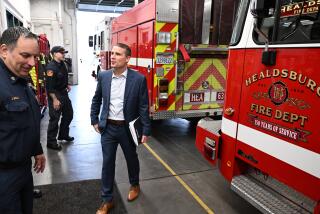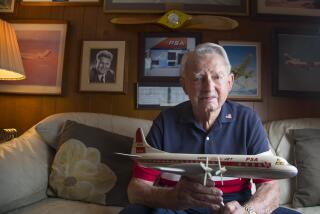The P-38 was the highest spot of my whole military career.
Thomas G. McGuire, retired Valley College English teacher and competitive marksman, fell in love nearly 50 years ago. The object of his affection was a sleek new airplane built in Burbank. McGuire, 70, writes for “Lightning Strikes,” the P-38 National Assn. newsletter. He lives in Van Nuys.
The first time I ever saw a P-38, some nut in San Francisco looped the Golden Gate Bridge. I thought, “Oh my God!” It was 1940. I just dreamed of that damned airplane all those years that I was flying other stuff.
I graduated as a pilot in December of 1943. I went down to Santa Ana on the old daylight train, 220 young guys. When the war was over, I think about 69 of them were still alive, out of 220. I was lucky, I guess.
I wanted to fly P-38s, but I was sent to instructor school. I taught advanced flying for all of 1944 and a little bit of ’45. I never lost one student. I like to think it was because I was very careful with them that I never lost one.
I first went to Pecos, Tex. At Pecos, there was a cadet killed every week or so. We killed 13 in one night. We killed more men in training in the States than we lost overseas. A new pilot would ask, “How many pine boxes are going out of here a week?” Those statistics have never been made available to the public.
We killed eight in one day at Chico. We killed nine in one day in Santa Rosa. My mother would phone the Red Cross from San Francisco because the paper would just say, “Midair collision in Santa Rosa, both pilots killed.” I didn’t know how hard it was on her.
I wanted to get out of the training command and into P-38s. Finally, I got my choice.
The P-38 is a wonderful airplane, a twin-fuselage, single-seat fighter. The cockpit is between the two engines. It’s got a lot of weight. It’s got a lot of power. It had a nice, soft, sweet hum about it. It was the most incredible thing there was. The P-38 fought in every theater in World War II. It was the first American airplane of any type to fly over Berlin.
No airplane ever had that many switches, lights and gadgets for one man to handle. It was harder to fly, more complicated. And it had the highest death rate in training and operation.
In fighters, a solo flight is a very hairy thing, but especially in a P-38. I was really scared, too. You’ve got two engines pulling like hell. You have to lock your wheels, your legs jammed against the brake pedals, and you run it up to 3,000 r.p.m.s. I just let go of the brakes, poured the coal to it and got a shock from that slam back against the seat. I never felt that before. I had never been in anything that powerful. I came around and made a good landing, too. I got this funny feeling about that afterward, like, “Did I really do that?”
I never went overseas. I flew P-38s out of Santa Rosa. Santa Rosa was a real fighting airport, with loaded guns in the planes, in defense of San Francisco. They were afraid the Jap submarines were going to come up and make a run over San Francisco.
When the war was over, I had the weird experience of ferrying beautiful brand-new P-38s from Lockheed to Kingman, Ariz., where they were just left to rot or to be chopped up.
When I got out of the service, they offered to sell me a P-38 for $1,300. I didn’t have the money then. I was going back to school, so I passed on that. Now one of those is worth $1 million.
They made 10,000 of them, but only 13 are left. The P-38 Assn. is having this big blowup in January in Santa Maria. They’ll have some P-38s flying, and you can walk up and look at them or climb up the ladder in back.
The P-38 was the highest spot of my whole military career. It was the greatest thing that ever happened to me. No words can really tell what it was like to fly those things at maximum performance. It was a most amazing kind of thing. I’ve never used narcotics, but one of the guys who has, told me that going 450 miles an hour at low altitude in a P-38 gives you a higher boost than any kind of drug.
More to Read
Sign up for The Wild
We’ll help you find the best places to hike, bike and run, as well as the perfect silent spots for meditation and yoga.
You may occasionally receive promotional content from the Los Angeles Times.






